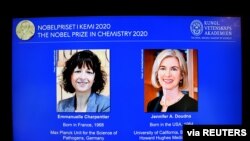The Nobel Prize in chemistry was awarded Wednesday for the first time to two women. The two researchers invented a method — CRISPR-Cas9 — that allows researchers to more easily change the DNA of animals, plants and microorganisms.
The research by Emmanuelle Charpentier and Jennifer A. Doudna was published in 2012, making it more recent compared with some Nobel-winning research, which is often honored only after decades have passed.
“I’m over the moon, I’m in shock,” Doudna, a professor at the University of California, Berkeley, said at a news conference on Wednesday.
Five women have previously won the Nobel in chemistry. This is the first time an all-female team won. In 1911, Marie Curie won the chemistry award, eight years after she became the first woman to a Noble prize for her work in physics. Curie's daughter, Irène Joliot-Curie, won the award in 1935. She was followed by Dorothy Crowfoot Hodgkin in 1964, Ada E. Yonath in 2009, and Frances H. Arnold in 2018.
Charpentier, the 51-year-old Frenchwoman who leads the Max Planck Unit for the Science of Pathogens in Berlin, said that while she considers herself first and foremost a scientist, “it’s reflective of the fact that science becomes more modern and involves more female leaders.”
CRISPR-Cas9 is a technique for cutting a gene at a specific spot, allowing scientists to manipulate flaws that are the root cause of many diseases. Genetic disorders such as sickle cell disease and hereditary blindness could be cured using this technology. Scientists are using it to create new crops and hope that extinct livestock could be re-introduced.
“There is enormous power in this genetic tool,” said Claes Gustafsson, chair of the Nobel Committee for Chemistry.









